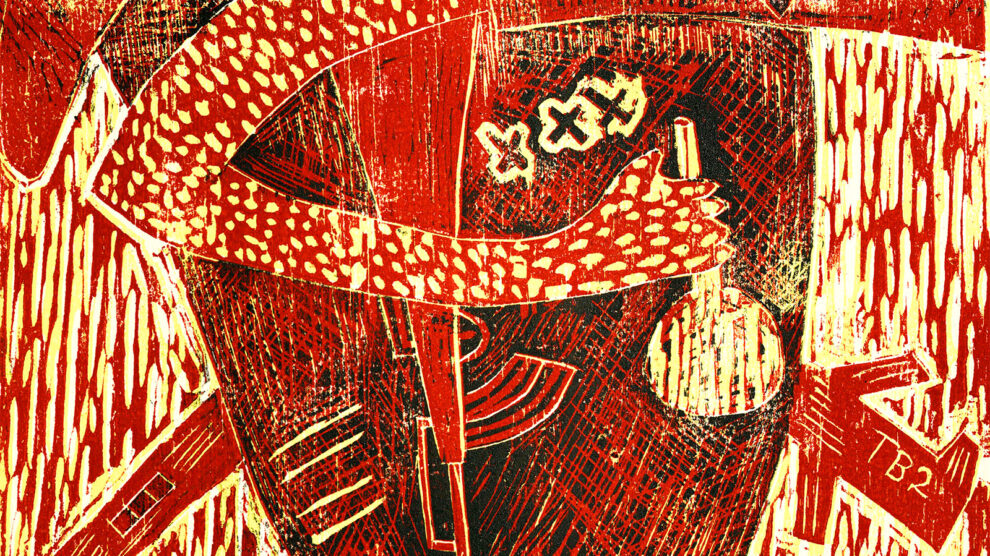July 7, 2022
Under the Influence of Lewontin: Volume Three
Lewontin Memorial Collection
Richard Lewontin passed away a little more than a year ago, on July 4, 2021. In the past year, we‘ve published series of articles in the special issue to commemorate and carry on the work of radical science. Many have contributed, including friends and colleagues of Dick offering personal stories (see Volume One and Two of articles with the same name). As we begin to wrap up the special memorial issue, we asked a few members of the editorial collective—the young generation of SftP’ers who never met Dick but learned through his corpus—to share their thoughts. There is little doubt that Dick would take pride knowing that SftP, radical science, and the intrepid spirit of iconoclasm live on. —Ed.
Contents
A Hot Summer Day Forever Ruined
By Zach Hall
Lewontin’s Influence on Evo-Devo
By Claire Ramsay
Toward a Dialectical Neuroscience
By Calvin Wu
A Hot Summer Day Forever Ruined
Zach Hall
I had the incredible misfortune of only first stumbling upon Richard Lewontin’s Biology as Ideology after attaining a tenure-track position as an Assistant Professor at the University of Alberta. I was sitting in a hammock at my parents’ home in rural Southwestern Ontario, basking in the summer’s humid emptiness while on long-term leave. After more than a decade of working at a lab bench, ignorant and isolated from the world around and beyond it, I assumed that I had done it—I had made it as a whole scientist. I hadn’t.
In only a brief hundred or so pages, Lewontin unstitched the artificial boundaries I had unknowingly weaved around myself to hold back a world that I thought was irrelevant and uninteresting to my research. Disarmed, I was no longer able to deny the (suddenly obvious) historical and contingent influences of the society around my work flooding inward. Halfway through the book, I paused to look out on neighboring farms. Tilled, nascent cornfields staked with small plastic signs annotating the hybrid varieties that, Lewontin had just explained, cannot be propagated and instead must be bought fresh every year from industrial supply. I felt like I was falling.
The cheap, pinstriped hammock from Canadian Tire gave way first, soon followed by the patio brick that I could remember helping my dad arrange and tamp down when I was a teenager. The ground itself would shatter and my clueless form continued downward, through my PhD, MSc, and Bachelors like a cheap awnings ripping away in an old slapstick comedy. The whole way down, I got mad and madder. In all these years, how come no one had challenged me to think about history? My research in the context of a whole world? How could I have been hired without knowing any of this? Why do we so celebrate such a voluntarily limited view of the natural world? Why is complexity considered a nuisance?
I landed in a pile of books: The Dialectical Biologist, Biology Under the Influence, Not in Our Genes, It Ain’t Necessarily So, and then Can Neuroscience Change Our Minds?, Genes, Cells, and Brains, The Ontogeny of Information, The Death of Nature, The Use and Abuse of Biology, The Science of Life and so many more. Only through such an explosion of reading could I find my feet again, for the first time on sturdy ground. The contingencies and complexities of the world that once made me scour, seen as ultimately unknowable sources of variation interfering with simple, positivistic group differences in my experiments became, for me, integral to a complex and dynamic nature.
Because of Lewontin and Levins, I will spend the rest of my life struggling to position myself and my research meaningfully in the tangled mess that is an interpenetrating, interactive, historical, and beautiful world. I will revel in complexity and resist shallow attempts to force nature to abide by simplistic rules amenable to patentable technology. I could never go back. I wouldn’t want to.
•
Zach Hall is an assistant professor at the University of Alberta in Edmonton, Canada. He studies the reciprocal development of the body and brain early in life. He is trying his best, but thinks he could probably do better.
Lewontin’s Influence on Evo-Devo
Claire Ramsay
I was already a PhD student studying the evolution and development (often referred to as evo-devo) of ants when I first read the work of Lewontin. I had been drawn to the field of evo-devo as I had found the view of evolution in which the differences we see between organisms boils down to changes in the relative frequencies of genetic alleles over time, as incomplete and difficult to square with what I had been taught about how genes lead to phenotype through an organism’s development.
Animals begin life as single cells, which through the process of development multiply and differentiate into the numerous specialized types of cell that make up an individual. This process involves the complex regulation of gene expression to determine the timing and location of cell differentiation. Development is also environmentally sensitive, sometimes dramatically so: this is the case in ants, where female ants of extremely distinct phenotypes, the reproductive queens and the non-reproductive workers, are produced through environmental regulation of development. Queen and worker ants share the same DNA, but nutrition and other environmental factors lead to differential expression of genes during development, leading to ants very different in size, behavior and morphology. Though ants are a dramatic example of this, that the environment has an influence over gene expression and phenotype is universally true. For this reason, how can we understand the evolutionary change in phenotype without understanding how phenotypes are produced during the interaction of development with the environment?
However, with the development of the modern synthesis (and the tendency to explain evolution in terms of changing allele frequencies), the centrality of development to evolution was sidelined, and only received real attention from the 1990s onwards, when evo-devo came into its own as a field. For this reason, looking back on Lewontin’s writings as far back as the 1970s and 80s, it is incredible to see how well his organism-centric, anti-reductionist view of evolution, with its emphasis on the dialectical relationships between organisms and their environments, reflects the research aims and theories of modern evo-devo.
For instance, one of Lewontin’s best-known articles is the Spandrels paper coauthored with Steven Jay Gould (The Spandrels of San Marco and the Panglossian Paradigm: A Critique of the Adaptationist Programme, published in 1979). This paper broke down the weaknesses of the adaptationist research agenda, which rests on the assumption that organisms can be broken down into discrete traits, for each of which must be given some adaptive reason for existence. Using an analogy to architectural spandrels, the triangular spaces formed at the top of abutting arches which are in often filled in with lavish paintings or moldings in cathedrals, Lewontin and Gould argue that we must consider non-adaptive explanations for biological traits: though the spandrels serve as a space for decoration, they exist because they are an architectural necessity. In the same way, a biological trait could be the product of constraints stemming from physical/biomechanical laws, phylogenetic heritage, and developmental processes. Strikingly, the alternative method to adaptationism incorporating these constraints is to center the whole organism and its development. Lewontin and Gould argue that organisms must be seen as integrated wholes, with a focus on evolutionary change in bauplans, i.e., the general body plan that characterizes a group of animals (e.g., a head, a thorax with six legs, and an abdomen in the case of insects). Understanding the evolutionary origins of and transitions between different morphologies later came to be a major focus of evo-devo. Lewontin and Gould state strongly their belief that development should be a central focus in the study of evolution, proposing that, “Developmental constraints…may hold the most powerful reign of all over possible evolutionary paths,” and that possibly, “the adaptationist program cannot explain the alteration of developmental programs underlying nearly all changes in Bauplan.”
Thus, this influential paper acknowledges development’s key role in shaping and constraining the phenotypic variation that fuels evolutionary change. Of course, a related aspect of development’s role in evolution, not emphasized strongly in the Spandrels paper but a major focus of Lewontin’s later work, is the way the environment shapes development. The idea of organisms as being in a dialectical relationship with their environments is laid out beautifully in The Dialectical Biologist and The Triple Helix: organisms cannot be considered as entities as separated from their environments, as the environment shapes their development and thus their phenotype, and they in turn shape their environment. These ideas have grown to loom large over modern evo-devo, with increasing interest in understanding phenotypic plasticity, niche construction, and epigenetic inheritance, and how these processes influence evolution.
In reading Lewontin’s work, it is wonderful to see how the field has come to accept, build on, and empirically test ideas Lewontin advocated throughout his career. Lewontin’s dialectical materialist worldview allowed him to appreciate what were, at the time, aspects of biology that were more or less ignored in theories and studies of evolution. That he was at all times conscious and upfront about his own Marxist ideology sets him apart from the tendency among scientists to see themselves and their own work as unbiased and objective, thus remaining unconscious of how dominant ideologies in society shape scientific practices and theories. Lewontin’s contributions to evolutionary biology show how a dialectical materialist perspective can enrich our view of nature and help us see beyond more mechanical, non-dialectical views of biology and evolution. Though I see evo-devo as in many ways intrinsically dialectical, the field too can benefit from more consideration of how its theories and approaches are shaped by politics and ideology.
•
Claire Ramsay is a PhD candidate at McGill University studying the evolution and development of reproductive division of labor between queen and worker ants. She grew up in Scotland before moving to Quebec, Canada.
Toward a Dialectical Neuroscience
Calvin Wu
I learned of Richard Lewontin by way of Richard Levins. Almost a decade ago, struggling through my PhD dissertation’s introductory chapter—on systems neuroscience, a far cry from evolutionary biology—I chanced upon a lecture titled “The Two Faces of Science.” It was recorded on a personal device from a member of the audience. Despite its low video and sound quality, the content of the lecture shattered my worldview.
Thus began my journey in the radical science movement. Ever since, I have sought to understand and practice science within the broader social context. The seminal essays by Levins and Lewontin in The Dialectical Biologist and Biology Under The Influence laid the foundation of my theoretical understanding, which was further refined by engaging the copious texts from the 1970s–80s Science for the People. When Lewontin passed away last year, as publisher of the revitalized SftP magazine, I and the editors—Claire Ramsay, Camille Rullán, and Edward Millar among others—wanted to use this memorial issue as a starting point to ask: how can we, a new generation of scientists, advance Levins’s and Lewontin’s legacies?
The answers soon unraveled; we identified two crucial aspects of radical science praxis. First and foremost is to reject the insularity of science by joining social movements and breaking the cult of expertise through which science is practiced today. Science must be democratic; and to be democratic, it must be accessible. Much more than education, communication, or representation, radical science requires immersion with the people in struggle and research forged through grassroots participation. At different scales, this could mean embarking on decentralized and community-oriented projects, challenging entrenched institutional structures through union organizing, or pursuing political actions to enact broader policy changes. Levins’s and Lewontin’s lifelong involvement in antiwar, anti-imperialist, and anti-racist organizing must inspire us toward this path.
Another aspect of praxis is the application of radical philosophy in scientific research itself. Levins and Lewontin revolutionized the research approach in population ecology and evolutionary genetics, respectively. Even the most “apolitical” scientist cannot deny that Levins’s and Lewontin’s dialectics, in the shape of Marx and Engels, made lasting contributions to the advancement of knowledge in their fields.
This second task seems the most daunting. For those struggling to survive in a hypercompetitive environment of science under neoliberalism, making research breakthroughs, let alone through a deep understanding of an iconoclast philosophy, is almost inconceivable. But the beauty of dialectics is that everything is in constant flux. Our thoughts and actions are co-determinants; the more we situate ourselves within radical social actions, the clearer we can scrutinize the inadequacy of science in the status quo.
In systems neuroscience, for instance, reductionism is ubiquitous. Each system is delineated by arbitrary boundaries (historically determined based on research techniques or proposed functions) that contain different brain regions. Parts are sufficient subjects of research as they determine the whole; the whole is a purely theoretical construct that exists without consideration of diversity and intricacies of the parts. The computational unit, or the “fundamental” part, is constantly being proposed and revised—it could be a single brain cell (neuron), a group of neurons (ensemble), or a whole area of the brain—but ultimately predisposed by techniques and ideology of the experimenter. Phenomena are only described as quantities, instead of as qualities with intrinsic or emergent properties. The active agency of the experimental subjects (be it mouse or human) are ignored… I could go on.
While there remains a significant gap between critiques and injection of a fuller (radical) vision into the everyday practice of neuroscience, I am optimistic that as dialectics takes a deeper root both in our consciousness and in our society, a radical shift in both cannot be far away. After all, a comprehensive political economy and philosophy based on the perspectives of the oppressed began humbly with the “ruthless criticism of everything existing.”
•
Calvin Wu is a neuroscientist at the University of Michigan. He studies neural circuits in the brainstem that contribute to sound perception.





